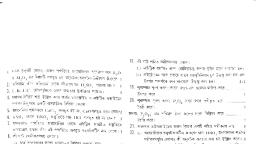Question 1 :
A person sees his virtual image by holding a mirror very close to the face. When he moves the mirror away from his face, the imagebecomes inverted. What type of mirror he is using
Question 2 :
If $f$ is focal length of the lens in $cm$, then the power of a lens is equal to:
Question 3 :
Choose the correct statement(s) related to the motion of object and its image in the case of  mirrors.
Question 5 :
When the height of the image is less than the height of the object, then magnification will be
Question 6 :
A wave has velocity v in medium P and velocity 2v in medium Q. If the wave is incident in medium P at an angle of 30, then the angle of refraction will be
Question 7 :
The incident ray, the _______ ray and the normal lie in the same plane during refraction.
Question 8 :
State whether true or false.<br/>A convex mirror always forms a real image.
Question 9 :
The focal length of convex lens is 30 cm and the size of image is quarter of the object, then the object distance is:-
Question 11 :
A ray of light travelling inside a rectangular glass block of refractive index $\sqrt2$ is incident on the glass-air surface at an angle o incidence of $45^o$.The refractive index of air is one. Under these conditions the ray will
Question 12 :
When a ray of light traveling from vacuum to a medium of refractive index $\mu $, the angle of incidence is twice the angle of refraction. The incident angle is :<br/>
Question 13 :
A convex lens of focal length 80 cm and concave lens of focal length 50 cm are combined together. What will be their resultant power?<br>
Question 15 :
It is desired to produce a real image on a screen using a convex lens of focal length 10 cm. The minimum distance between the object and the screen should be then<br/>
Question 16 :
A biconvex lens of focal length f forms a circular image of radius r of sun in focal plane. Then which option is correct?<br/>
Question 17 :
A square wire of side $3.0 cm$ is placed $25 cm$ in front of a concave mirror of focal length $10  cm$, with its centre on the axis of the mirror and its plane normal to the axis. The area enclosed by the image of the wire is :<br/>
Question 18 :
The refractive index of water with respect to air is1.33. The refractive index of air with respect towater will be
Question 19 :
A ray of light is incident on a glass slab making an angle of $60^0$ with the surface. Calculate the angle of refraction in glass and the velocity of light in glass if the refractive index of glass and the velocity of light in air are 1.5 and 3.0 x 10$^{8}$ m/s respectively.<br/>
Question 20 :
Assertion: Thinner lenses have smaller power.
Reason: Power is directly proportional to the focal length
Question 21 :
Three convex lenses are available having focal lengths of $4 cm, 40 cm$ and $4 m$ respectively. Which one could be used as magnifying glass?
Question 22 :
The reflecting surface is given by $y = \dfrac{10L}{\pi} \sin \dfrac{\pi x}{5L}$. The co-ordinates of the point where a horizontal ray becomes vertical after reflection is:
Question 23 :
The distance between an object and its doubly magnified image by a concave mirror is: [ Assume $f$ = focal length]
Question 24 :
A concave shaving mirror has a radius of curvature of 35.0 cm. It is positioned so that the (upright) image of a mans face is 2.50 times the size of the face. How far is the mirror from the face?
Question 25 :
The magnitude of focal length of a concave mirror is $f$. An object is placed at a distance $x$ from the focus and forms a real image. The magnification is:<br/>































